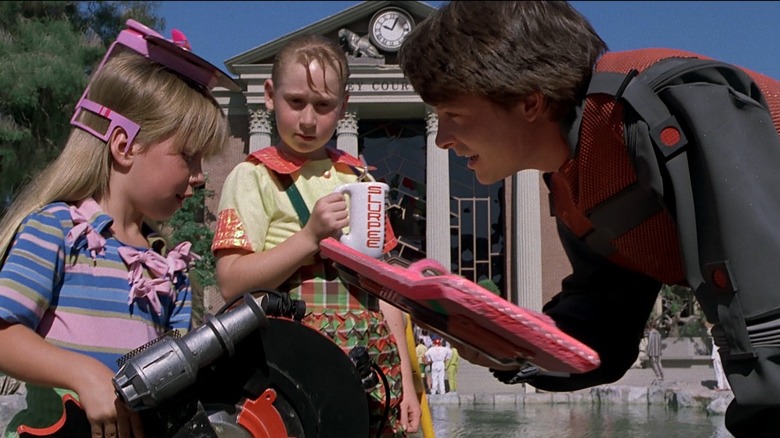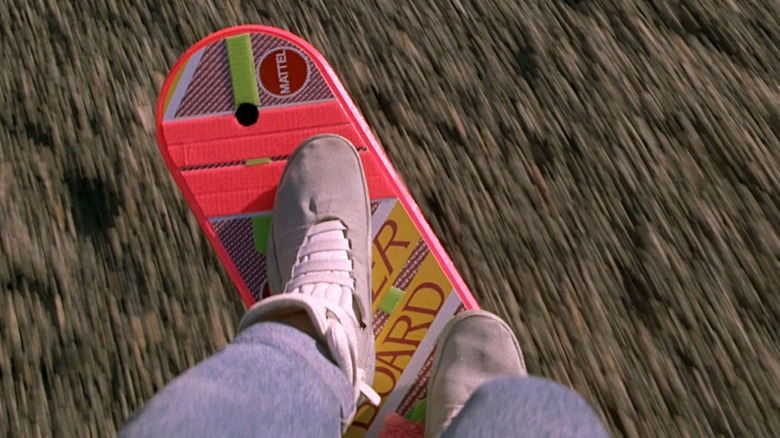It Took Almost Every Technique In The Book To Make The Hoverboards Fly In Back To The Future Part II
Anyone who was a child in 1989 could likely repeat the widely circulated rumor that hoverboards — the wheel-less, floating skateboards featured in Robert Zemeckis' "Back to the Future Part II" — were 100% real. Given the nature of rumors, few children could pinpoint its origin. The information circulated was that parents were writing angry letters to hoverboard manufacturers, even before their release, that hoverboards weren't safe, spoiling fun for kids everywhere. Another rumor was that, during the "testing phase" of the toy, a young boy had died after falling off of a hoverboard, leading to their abandonment. Rumors are so insidious that actor Thomas F. Wilson, who ably plays various members of the Tannen family across all three "Back to the Future" feature films, wrote a novelty song about how often he's asked about the hoverboards, as well as every other topic he's grilled on by casual fans who approach him on the street.
The truth: Kids savvy enough to be paying attention to a promotional videos released alongside "Back to the Future Part II" might have caught the 1989 interview with Zemeckis where he explained, rather convincingly, that hoverboards were real, they worked using magnetic fields, and that he secured several for use in the movie. He said they weren't available because parents groups wrote in and demanded they be restricted.
This was, sadly, Zemeckis merely playing a merry prank. In actuality, a complicated mixture of multiple VFX techniques were employed to create the hoverboards in "Back to the Future Part II," taking advantage of some cutting-edge tools, as well as decades-old FX tricks.
"Hey little girl, let me borrow your...hoverboard?"
In "The Secrets of the Back to the Future Trilogy," a 20-minute making-of documentary short released on VHS in 1990 and sold alongside the three "Back to the Future" films in a VHS box set, host Kirk Cameron shares some of the secrets — well, he explains production details — about how hoverboard were realized visually.
Firstly, and rather simply, the from-the-knee-up shots of actor Michael J. Fox riding a hoverboard actually had the actor riding an ordinary skateboard. Fox was already a proficient skateboarder, and had already done a few skating stunts on the set of the first "Back to the Future," so most of what we're seeing is Fox plying his skills. In "Back to the Future Part II," set partly in the far-flung future of 2015, Fox must ride a hoverboard over city streets, but also gravel, and other surfaces not amenable to skateboards. The crew merely laid down a "track" of plywood, and Fox would ride across them. Additionally, Fox would sometimes ride around on a hoisted platform dolly, pulled by the crew.
In short, any shot where you didn't see Fox's feet, there was no hoverboard.
The old harness-and-crane trick
There were, however, several shots in "Back to the Future Part II" wherein audiences saw full-body shots of Fox flying through the air on a hoverboard. To achieve this, Zemeckis and his crew came up with a large system of cranes and cables that were attached to a special harness worn by the actor. The hoverboard itself, a wooden prop, was drilled to Michael J. Fox's shoes, and stagehands had to carry him around the set. Fox would be suspended from the cables, and the crane would swing him around. Camera angles and photographic tricks were used to obscure the cables.
In the close-up, from-underneath shots of the hoverboards zipping down the street, Fox and the rest of the actors riding hoverboards were suspended from a miniature scaffold attached to a truck. They would simply dangle their hoverboarded feet over the street, and a low-set camera would film.
The shots of the hoverboards being thrown down to the ground, only to "bounce" on their magnetic fields were achieved with optical effects. A puppeteer would lower the hoverboard on wires in front of a blue screen, then that shot would be composited into the completed scene.
Because the film was made in the late 1980s, CGI was still a long way off as the primary source of VFX for major studio feature films. While some practical effects are always going to be more, well, practical — it seems actors will always be dangled from cables in flying scenes — 2022 would dictate that the hoverboard effects be achieved inside computers. Zemeckis has never been one to shy away from the latest VFX technology. For better or worse, he made three animated films that tested the limits of motion-capture tech, as well as one of the best-looking 3D films ever released ("The Walk"). Had Zemeckis made a film like "Back to the Future Part II" in the present, the effects would have undoubtedly been just as dazzling as they were in 1989.

